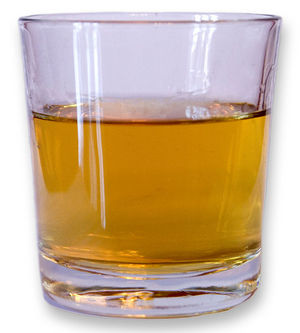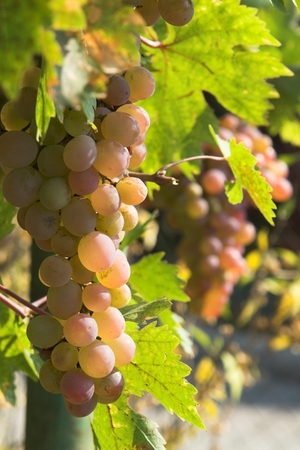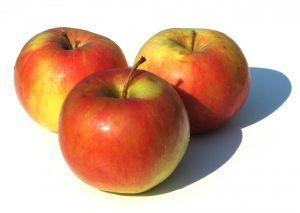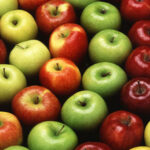The word brandy or brandywine comes from the Dutch word brandewijn which translates to “burnt-wine”. This however is a misnomer as brandy is actually distilled wine whereas many beverages do actually involve burning wine, such as vin-brule.
Brandy usually refers to the distillate of grape wine although the term is occasionally used for distillates of other fruit wines. Some common examples of non-grape brandies include Applejack (a distillate of hard apple cider) and Kirschwasser (a distillate of cherry wine). For the purposes of this article we will assume one is trying to prepare a typically grape wine brandy.
To begin you need the neutral distillate of grape wine. The easy (and legal) way to do this is to simply buy a “pomace brandy” which are generally un-aged and and uncolored brandy bottled immediately after distillation. Alternatively you could use a neutral grain spirit, such as 190 proof Everclear, and cut it down to about 40% alcohol by mixing 4 to 6 with water (this would technically produce a whiskey, but the taste will be similar to brandy.) Or finally you can distill your own wine (which is illegal in the USA and Canada, but I will give an explanation of a basic setup for educational purposes only).
When one distills wine for the purpose of making brandy, typically involves higher-acidity white wines. Cheap Chardonnay will work fine. A simple still can be easily made as follows….Find a rubber stopper that fits tightly inside a one-gallon glass jug. Drill a 7/32″ hole in the stopper and run a piece of 1/4 inch copper tube out of the hole. The copper tube should only go 1-2″ into the jug and should remain above the level of the wine being distilled at all times. A second hole should be drilled appropriately to fit the end of a small thermometer into the jug and placed as such. The jug can then be placed into a large crock pot and the temperature set such that the wine is just below boiling (200 degrees is a good temp). The other end of the copper tube must be below the level of the bottom of the jug and should be set up to drip into a container to catch the distillate or raw-brandy. Throw out the first 1/4 cup of liquid caught called the “heads” as this contains methanol and other nasty things which will not just make the taste bad, but in extreme excess can cause blindness (you can’t go blind from the amount in 1 gallon of wine, but it will give a hell of a hangover). From one gallon of wine you should be able to distill out about two 750 ml bottles of brandy (two regular sized wine bottles). This might take a few days. Lower temp is slower and produces a higher alcohol concentration. Hotter is faster, but less strong (even at boiling you will still get at least 30% alcohol).
Next your brandy needs to be oak aged. Get some small oak planks or cut oak into thin enough strips that they will through the mouth of a wine bottle and about 2/3 the height of the bottle in which the brandy will be aged. Then you need to toast your oak planks. It suffices to wrap them in aluminum foil and put them in the oven for four hours. For an oaky flavor, toast at 250 F. For sweet aromatic flavor toast at 300 F. Vanilla notes peak at around 400 F while going up to 420 or 440 F will give a toasty taste. Almond taste peaks at 520 F, but much higher than that starts to taste terribly bitter For brandy 300 F is a works well. If you want something a bit stronger with a taste more like whiskey, try 400-420 F.Although there won’t really be smoke that you can see, it will smell very very smoky around so you may want to open the windows a little while you do this. By the way, your kitchen will smell like you recently cooked the world’s best barbecue for several days and will make you hungry as hell every time you’re in there.
Now the really hard part….You need to age your brandy with the oak plank in it for a long time. The distillate will start clear, but will acquire the familiar caramel color as it ages. After 2-3 months it will be the proper color, but the taste will still be quite harsh. After one year you will have something that tastes like bottom shelf brandy. By the time two years has elapsed you will have something quite good.
Brandy has a ranking system based on the length of time it is oak aged and the quality improves with time (the quality only improves when the oak plank is present, it will not improve in the bottle like wine)….
A.C. marked brandy is aged 2 years.
V.S. “Very Special” has been aged at least 3 years.
V.S.O.P “Very Superior Old Pale” is aged at least 5 years.
X.O “Extra Old” must be aged at least 6 years.
Also check out some of my other articles such as How to Make Homemade Whiskey and How to Make Your Own Hard Cider.
Please enjoy the recipe responsibly and don’t drink and drive. Enjoy!






